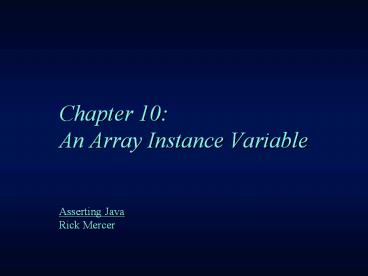Chapter 10: An Array Instance Variable PowerPoint PPT Presentation
Title: Chapter 10: An Array Instance Variable
1
Chapter 10 An Array Instance Variable
- Asserting Java
- Rick Mercer
2
A Collection Class
- Programmers often use collection classes
- classes with the main purpose of storing a
collection of elements that can be treated as a
single unit - For example, class Bank might store a collection
of BankAccount objects and provide appropriate
access to the individual elements - A Few Java collection class names
- Stack a collection of objects with access to
the one on top - ArrayList a collection of objects with the
List operations - TreeSet a collection of unique objects
- HashMap collection to provide fast adds,
removes, finds
3
Characteristics of a collection class
- Main responsibility store a collection of
objects - Can add and remove objects from the collection
- Provides access to individual elements
- May have search-and-sort operations
- Some collections allow duplicate elements
(ArrayList), other collections do not (class Set
for example) - Some collections have a natural
ordering--OrderedSet--other collections do
not--ArrayList
4
What about arrays?
- Is an array a collection?
- arrays are objects, they do have similar
characteristics, however - subscripts are needed to access individual
elements - programmers have to spend a lot of time
implementing array based adds, removes, sorts,
and searches - arrays are lower level
- Arrays provides programmers with the opportunity
to make more more errors and spend more time than
using a collection class
5
class StringBag
- The StringBag class
- represents a mathematical bag or multi-set
- is a simple collection class
- will have an array instance variable
- is a collection capable of a storing only strings
elements actually references to string objcets - is not a "standard", but this allows us to see
the inner working of the class
6
A StringBag class continued
- A StringBag object
- stores a collection of String elements that
- are not in any particular order
- are not necessarily unique
- understands these messages
- add occurencesOf remove
7
StringBag with no implementation
- // A class for storing a multi-set (bag) of
String elements. - public class StringBag
- // Construct an empty StringBag object (no
elements yet) - public StringBag()
- // Add a string to the StringBag in no
particular place. - public void add(String stringToAdd)
- // Return how often element equals one in this
StringBag - public int occurencesOf(String element)
- return 0
- // remove first element that equals
elementToRemove - public boolean remove(String elementToRemove)
- return false
8
A test method for add and occurencesOf
- _at_Test
- public void testAddAndOccurencesOf()
- StringBag sb new StringBag()
- sb.add("Marlene")
- sb.add("Eric")
- sb.add("Marlene")
- sb.add("Eric")
- sb.add("Marlene")
- assertEquals(3, sb.occurencesOf("Marlene"))
- assertEquals(2, sb.occurencesOf("Eric"))
- assertEquals(0, sb.occurencesOf("Not here"))
9
Implement StringBag methods
- The constructor creates an empty StringBag
- no elements in it, size is 0
- public StringBag()
- size 0
- data new String20
10
StringBag add
- The StringBag.add operation adds all new elements
to the "end" of the array if there is "room" - public void add(String stringToAdd)
- // If there is no more room, do nothing
- // Otherwise, place at end of array
- could we have added stringToAdd at the
beginning?____?
11
StringBag occurencesOf
- The occurencesOf method returns how often the
argument equals a StringBag element - public int occurencesOf (String value)
12
StringBag remove
- StringBag remove uses sequential search to find
the element to be removed (arbitrallily use the
first when occurencesOf gt 1 - If the element is found,
- move the last element datasize-1 into the
location of the removal element - place null into where the last element was
- done to release the memory for garbage collection
- decrease size by 1
13
State of s1 before removing "Jignesh"
Array Data Field State data0
"Kelly" data1 "Jignesh" data2
"Kristen" data3 "Maya" data4
null ... null size
4 local objects in StringBag remove removalCand
idate "Jignesh" subscript 1
14
The state after removing "another string"
1. Find removalCandidate in data1 2. Overwrite
data1 with "Maya" (the last element and
decrease size by 1
data0 "Kelly" data1 "Maya "Jignesh" data2
"Kristen" data3 "Maya" ... size 3
Erase reference to "Jignesh" No longer
meaningful Decrease number of elements in the bag
15
StringBag removecalls a private helper method
indexOf
- public boolean remove(String stringToRemove)
- boolean result false
- // Get subscript of stringToRemove or -1 if
not found - int subscript indexOf(stringToRemove)
- if(subscript ! -1)
- // Move the last string in the array to
- // where stringToRemove was found.
- datasubscript datasize-1
- // Release that memory to be reused for any
object - datasize-1 null
- // And then decrease size by one
- size--
- // return true to where the message was
sent - result true
- return result
16
Code Demo Complete StringBag remove that shifts
all elements
- public boolean remove(String stringToRemove)
- // Get subscript of stringToRemove or -1 if
not found - int subscript indexOf(stringToRemove)
- if(subscript lt 0)
- return false
- else
- // Shift all elements left so this array
- "Kelly", "Jignesh", "Kristen", "Maya", null,
null - // would change to this
- "Kelly", "Kristen", "Maya", null, null, null
- // don't forget to return true and reduce
size

